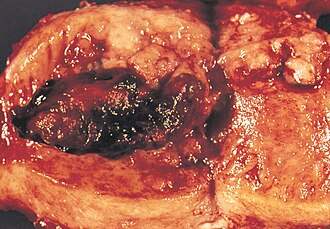Hysterectomy for endometrial cancer grossing
The protocol is for grossing a hysterectomy for endometrial cancer.
Hysterectomies with endometrial hyperplasia are dealt with in the hysterectomy for hyperplasia protocol.
Introduction
This is a very common procedure as endometrial cancer.
Opening
Orientation of hysterectomies
- Less peritoneum on anterior (as the urinary bladder is there).
- Posterior peritoneal edge: pointy (upside down triangle).
- Anterior peritoneal edge: rounded/non-pointy.
- Posterior peritoneal edge: pointy (upside down triangle).
- Tubes on anterior-lateral aspect.[1]
- Round ligaments posterior to tubes.
Protocol
Specimen:
- Hysterectomy for endometrial cancer.
External measures:
- Uterus and cervix: ___x___x___cm
- Specimen mass: ____grams.
- Left ovary: ___x___x___cm.
- Left fallopian tube ___x___cm.
- Right ovary: ___x___x___cm.
- Right fallopian tube: ___x___cm.
- Exocervix: ___cm.
- Cervical os: ___cm, round/slit-like, probe patent.
Appearance:
- Shape: [pear-shaped/distorted].
- Serosal surface: [smooth, shiny, powder-burn lesions].
- Serosa nodules/lesion/mass: [none, present ___cm in greatest dimension].
- Ectocervix: tan-white glistening.
- Left ovary: [unremarkable / atrophic / cortical cysts].
- Left fallopian tube: [unremarkable / paratubal cysts].
- Right ovary: [unremarkable / atrophic / cortical cysts].
- Right fallopian tube: [unremarkable / paratubal cysts].
Internal measures:
- Endometrial cavity: ____x____cm.
- Myometrial wall thickness (maximum): ____cm.
Tumour:
- Dimension: ___x___x___cm.
- Location: [fundus/body, involves anterior and/or posterior wall, lower uterine segment, cervix].
- Appearance: [ill-defined, soft, friable, polypoid-shape, tan-white].
- Maximum depth of invasion: ___cm.
- Myometrial thickness: ___cm.
- Grossly normal endometrium - maximum thickness: ___cm.
Other findings:
- Myometrial tumour(s):
- Location: intramural / subserosal.
- Appearance: white, firm, whorled.
- Size range: ___-___cm in greatest dimension.
- Other features:
- Hemorrhage: absent.
- Necrosis: absent.
Inking code:
- Green - anterior serosa.
- Black - posterior serosa.
Representative sections:
- Anterior cervix.
- Anterior lower uterine segment.
- Posterior cervix.
- Posterior lower uterine segment.
- Tumour and anterior endomyometrium with greatest depth of invasion, full thickness sections [submit two full thickness section of deepest invasion from each involved wall of the myometrium with inked serosa].
- Tumour and posterior endomyometrium with greatest depth of invasion, full thickness sections.
- Additional sections of the tumour [for a total of at least one section/cm of tumour].
- Section of firm whorled tan nodules in anterior/posterior myometrium.
- Any other lesions.
- Right ovary.
- Right fallopian tube [fimbria submitted entirely].
- Left ovary.
- Left fallopian tube [fimbria submitted entirely].
Protocol notes
In BRCA1 mutation or BRCA2 mutation carriers, the ovaries and tubes should be submitted in total.[2]
Alternate approaches
See also
Related protocols
References
External links
- ↑ Lester, Susan Carole (2010). Manual of Surgical Pathology (3rd ed.). Saunders. pp. 425. ISBN 978-0-323-06516-0.
- ↑ Downes, MR.; Allo, G.; McCluggage, WG.; Sy, K.; Ferguson, SE.; Aronson, M.; Pollett, A.; Gallinger, S. et al. (Aug 2014). "Review of findings in prophylactic gynaecological specimens in Lynch syndrome with literature review and recommendations for grossing.". Histopathology 65 (2): 228-39. doi:10.1111/his.12386. PMID 24495259.
